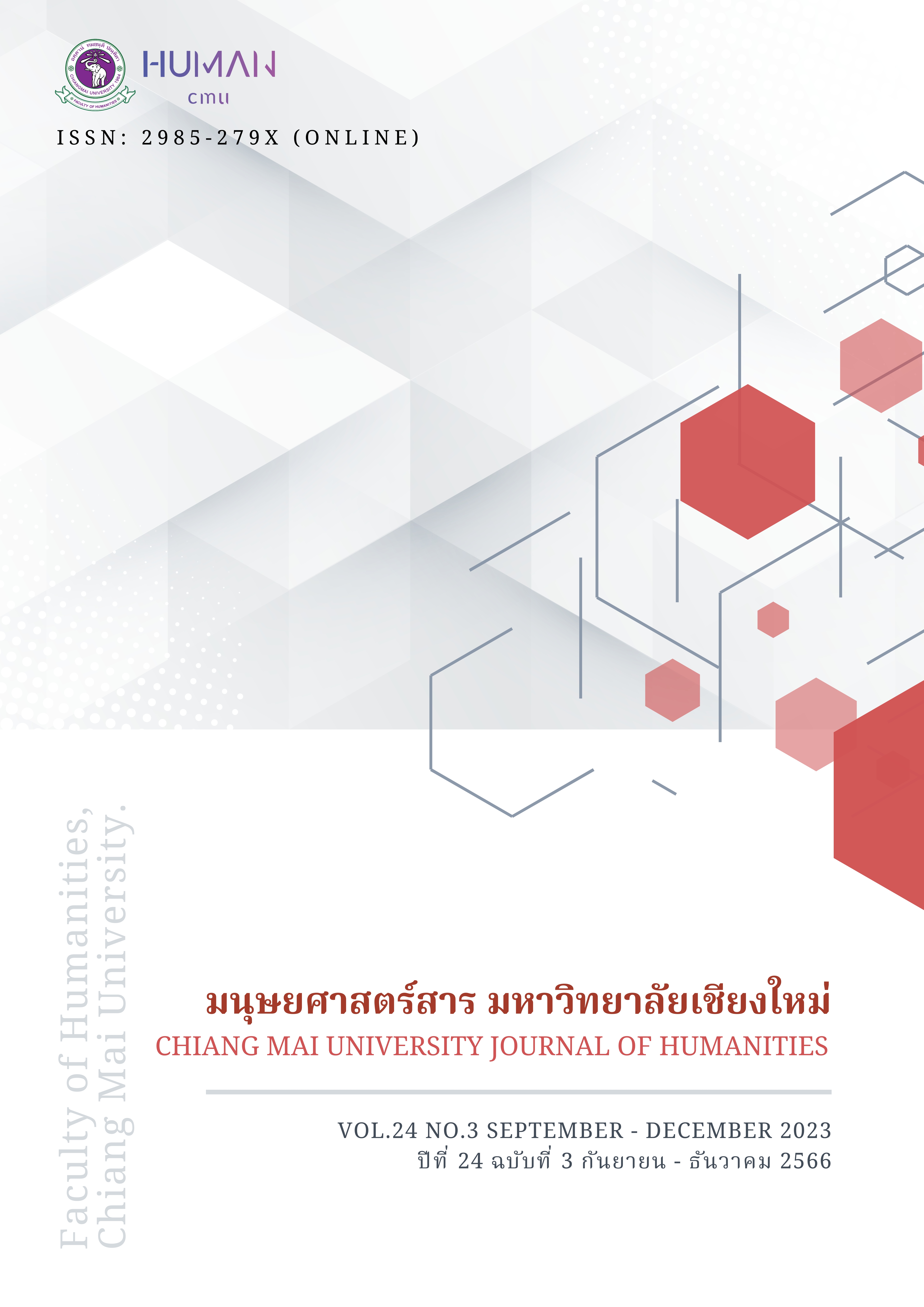ความถี่และความแม่นยำของการตอบสนองและคำแนะนำจากฟรีแกรมมาลี (Free Grammarly) ในการช่วยแก้ไขข้อผิดพลาดในการเขียนภาษาอังกฤษของนักศึกษาไทยในระดับมหาวิทยาลัย
Main Article Content
บทคัดย่อ
การวิจัยครั้งนี้มีวัตถุประสงค์เพื่อศึกษาความสามารถของปัญญาประดิษฐ์ที่เรียกว่าฟรีแกรมมาลี (Free Grammarly) ในการตรวจสอบและแก้ไขข้อผิดพลาดในการเขียนภาษาอังกฤษของนักศึกษาชาวไทยที่ใช้ภาษาอังกฤษในฐานะภาษาต่างประเทศ กลุ่มตัวอย่างในการวิจัยครั้งนี้คือ นักศึกษาชาวไทยที่ใช้ภาษาไทยเป็นภาษาแม่ และเป็นนักศึกษาที่ได้ลงทะเบียนเรียนในรายวิชาการเขียนย่อหน้าภาษาอังกฤษในหลักสูตรนานาชาติของมหาวิทยาลัยแห่งหนึ่ง จากการทบทวนวรรณกรรมที่เกี่ยวข้องสามารถระบุและยืนยันได้ว่ามีการค้นพบข้อผิดพลาดที่เกิดขึ้นซ้ำๆในงานเขียนภาษาอังกฤษในฐานะภาษาต่างประเทศของนักศึกษาชาวไทย แต่ก็มีแนวโน้มว่านักศึกษาชาวไทยจะกลับมาใช้ปัญญาประดิษฐ์นี้เพื่อช่วยในงานเขียน เพื่อศึกษาว่านักศึกษาชาวไทยที่ใช้ภาษาอังกฤษในฐานะภาษาต่างประเทศสามารถเข้าถึงการช่วยเหลือที่มีประสิทธิภาพและแม่นยำของปัญญาประดิษฐ์ที่เรียกว่าฟรีแกรมมาลี (Free Grammarly) นั้น ผลงานเขียนย่อหน้าจากนักศึกษาชาวไทยจำนวน 30 ชิ้นได้ถูกอัพโหลดลงไปในปัญญาประดิษฐ์นี้เพื่อระบุประเภทและความถี่ของข้อผิดพลาด รวมทั้งคำแนะนำจากปัญญาประดิษฐ์ดังกล่าว เพื่อช่วยแก้ไขเนื้องานให้ถูกต้อง ผลจากการศึกษาสามารถระบุว่าการทำงานของปัญญาประดิษฐ์ดังกล่าวถูกนำมาใช้เป็นตัวช่วยในการเขียน แต่คำแนะนำที่ปรากฏออกมาจากการประมวลผลของปัญญาประดิษฐ์นี้ก็ยังแสดงถึงข้อผิดพลาดในเชิงบริบทและไวยากรณ์ เพื่อช่วยให้ทั้งนักศึกษาและอาจารย์ผู้สอนได้ตระหนักถึงข้อจำกัดของปัญญาประดิษฐ์นี้ ผู้วิจัยได้ระบุและวิเคราะห์คำแนะนำที่ผิดของตัวอย่างงานเขียนที่มาจากการประมวลผลของปัญญาประดิษฐ์ที่ชื่อฟรีแกรมมาลี (Free Grammarly) นี้ และได้ให้การตีความเชิงลึกเกี่ยวกับข้อผิดพลาด และข้อเสนอแนะในการตรวจสอบความถูกต้องของข้อผิดพลาดในเชิงบริบทและไวยากรณ์ด้วยตัวผู้เขียนเอง นอกจากนี้งานวิจัยชิ้นนี้ผู้เขียนได้สรุปข้อเสนอแนะในการใช้ฟรีแกรมมาลีให้กับอาจารย์และนักศึกษาในชั้นเรียน และการตั้งค่าภาษาของซอฟแวร์ และการใช้ประโยชน์จากเกร็ดความรู้ของฟรีแกรมมาลีนอกจากนี้ยังสามารถใช้ประโยชน์จากข้อแนะนำนี้ในการพัฒนาต่อยอดงานวิจัยได้ในอนาคต
Article Details

อนุญาตภายใต้เงื่อนไข Creative Commons Attribution-NonCommercial-NoDerivatives 4.0 International License.
เอกสารอ้างอิง
Abdul-Kareem, N. T. (2014). Difficulties faced by EFL students in writing composition at the Iraqi preparatory schools. Al-Fatih Journal, 10(60), 1-19. https://www.iasj.net/iasj/download/67f32a1198c7bc2b
Al-Seyabi, F., & Tuzlukova, V. (2014). Writing problems and strategies: An investigative study in the Omani school and university context. Asian Journal of Social Sciences & Humanities, 3(4), 37-48. http://www.ajssh.leena-luna.co.jp/AJSSHPDFs/Vol.3(4)/AJSSH2014(3.4-05).pdf
Al-Zayad, N. (2018). Difficulties faced by ninth grade EFL students when practicing writing skills: spelling and punctuation marks. [Master degree thesis, Faculty of Arts and Sciences Department of English Language and Literature]. Middle East University. https://meu.edu.jo/libraryTheses/5adc58afc9a7a_1.pdf
Bayat, N. (2014). The effect of the process of writing approach on writing success and anxiety. Education Sciences, 14(3), 1133-1141. https://files.eric.ed.gov/fulltext/EJ1034097.pdf
Bennui, P. (2008). A study of L1 interference in the writing of Thai EFL students. Malaysian Journal of ELT Research, 4(1), 72-102. https://www.melta.org.my/journals/MAJER/downloads/majer04_01_06.pdf
Bouchoux, D. E. (2019). Legal research and writing for paralegals, 9th. ed. Wolters Kluwer.
British Council. (2021). Understand and explain the IELTS scores. https://takeielts.britishcouncil.org/teach-ielts/test-information/scores-explained
Fahmi, M. A., & Cahyono, B. Y. (2021). EFL students' perception of the use of Grammarly and teacher feedback. JEES (Journal of English Educators Society), 6(1), 18-25. https://doi.org/10.21070/jees.v6i1.849
Fitria, T. N. (2021). Grammarly as AI-powered English writing assistant: Students' alternative for English writing. Metathesis. Journal of English Language, Literature, and Teaching, 5(1), 65-78. https://doi.org/10.31002/metathesis.v5i1.3519
Ghufron, M. A., & Rosyida, F. (2018). The role of Grammarly in assessing English as a foreign language (EFL) writing. Lingua Cultura, 12(4), 395-403. https://doi.org/10.21512/lc.v12i4.4582
Hogue, A. (2017). Longman academic writing series 2: paragraphs, 3rd. ed. Pearson Education.
Jeanjaroonsri, R. (2023). Thai EFL learners’ use and perceptions of mobile technologies for writing. LEARN Journal: Language Education and Acquisition Research Network, 16(1), 169-193. https://so04.tci-thaijo.org/index.php/LEARN/article/view/263438/178422
Khumphee, S., & Yodkamlue, B. (2017). Grammatical errors in English essays written by Thai EFL undergraduate students. Journal of Education, Mahasarakham University, 11(4), 139-154. http://edu.msu.ac.th/journal/home/journal_file/388.pdf
Lytvyn, M. (2022, November 9). A History of Innovation at Grammarly. Grammarly.com. https://www.grammarly.com/blog/grammarly-12-year-history
Ma, X., Wannaruk, A., & Lei, Z. (2019). Exploring the relationship between learning motivation and L2 WTC in an EFL classroom among Thai EFL learners. English Language Teaching, 12(7), 33-45. https://doi.org/10.5539/elt.v12n7p33
Mammadova, T. (2019). Teaching grammar to a grammar-free generation. Cambridge Scholars Publishing.
Phettongkam, H. (2017). Grammatical errors in spoken English of undergraduate Thai learners in a communicative business English course. LEARN Journal: Language Education and Acquisition Research Network, 10(1), 95-118. https://so04.tci-thaijo.org/index.php/LEARN/article/view/135963
Phoocharoensil, S., Moore, B., Gampper, C., Geerson, E., Chaturongakul, P., Sutharoj, S., & Carlon, W. (2016). Grammatical and lexical errors in low-proficiency Thai graduate students’ writing. LEARN Journal: Language Education and Acquisition Research Network, 9(1), 11-24. https://so04.tci-thaijo.org/index.php/LEARN/article/view/102659
Ranalli, J., & Yamashita, T. (2022). Automated written corrective feedback: Error correction performance and timing of delivery. Language Learning & Technology, 26(1), 1–25. http://hdl.handle.net/10125/73465
Rattanadilok Na Phuket, P. & Bidin, S. J. (2016). Native language interference in writing: A case study of Thai EFL learners. International Journal of Foreign Language Teaching and Research, 4(16), 25-36. https://jfl.iaun.iau.ir/article_586730_b1d3f62b0f7f88bd1d8367454c933b63.pdf
Roongsitthichai, A., Sriboonruang, D., & Prasook, S. (2019). Error analysis in English abstracts written by veterinary students in Northeast Thailand. Chophayom Journal, 30(3), 21-30. https://so01.tci-thaijo.org/index.php/ejChophayom/article/view/193083
Sermsook, K., Liamnimit, J., & Pochakorn, R. (2017). An analysis of errors in written English sentences: A case study of Thai EFL students. English Language Teaching, 10(3), 101-110. https://files.eric.ed.gov/fulltext/EJ1130033.pdf
Suraprajit, P. (2021). An analysis of errors in English essays written by Thai non-English major students. Theory and Practice in Language Studies, 11(1), 12-19. https://tpls.academypublication.com/index.php/tpls/article/view/803/572
Tananuraksakul, N. (2012). Psychological and linguistic identities in a Thai EFL/ELF context. International Journal of Language Studies, 6(3), 81-98. https://drive.google.com/file/d/1ethfDHlfsZuQO6XCWgcOBB72N-pHyI77/view
Tarin, S., & Yawiloeng, R. (2022). Using mind-mapping to develop EFL students’ writing performance. English Language Teaching, 15(11), 14-24. https://doi.org/10.5539/elt.v15n11p14
Thi, N.K., Nikolov, M. (2022). How teacher and Grammarly feedback complement one another in Myanmar EFL students’ writing. Asia-Pacific Education Researcher, 31(1), 767-779. https://doi.org/10.1007/s40299-021-00625-2
Visaltanachoti, C., Viriyavejakul, C., & Ratanaolarn, T. (2021). Teaching English to Thai students using an artificial intelligence technology algorithmic model: A prototype analysis. Turkish Journal of Computer and Mathematics Education, 12(14), 5623-5630. https://turcomat.org/index.php/turkbilmat/article/view/11718
Waelateh, B., Boonsuk, Y., Ambele, E. A., & Jeharsae, F. (2019). An analysis of the written errors of Thai EFL students’ essay writing in English. Songkla Nakarin Journal of Social Sciences and Humanities Research in Asia, 25(3), 55-82. https://so05.tci-thaijo.org/index.php/psujssh/article/download/242002/164628/833630
Watcharapunyawong, S., & Usaha, S. (2013). Thai EFL students’ writing errors in different text types: The interference of the first language. English Language Teaching, 6(1), 67-78. URL: http://dx.doi.org/10.5539/elt.v6n1p67
Yousofi, R. (2023). Grammarly deployment (in) efficacy within EFL academic writing classrooms: an attitudinal report from Afghanistan. Cogent Education, 9(1), 1-27. https://doi.org/10.1080/2331186X.2022.2142446
Zhang, J., Ozer, H. Z., & Bayazeed, R. (2020). Grammarly vs. face-to-face tutoring at the writing center: ESL student writers’ perceptions. Praxis: A Writing Center Journal, 17(2), 34-47. https://repositories.lib.utexas.edu/bitstream/handle/2152/81515/Zhangetal-paginated.pdf;sequence=2
Zhang, X. (2017). Reading–writing integrated tasks, comprehensive corrective feedback, and EFL writing development. Language Teaching Research, 21(2), 217–240. https://doi.org/10.1177/1362168815623291


